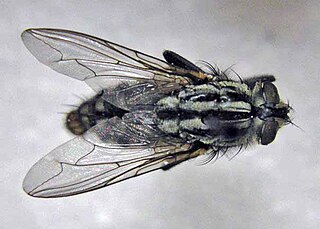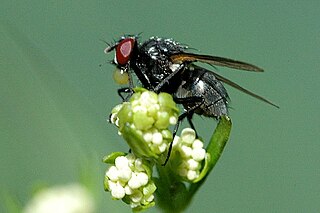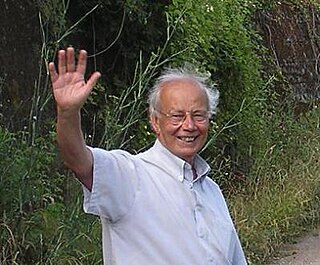
The Outback is a remote, vast, sparsely populated area of Australia. The Outback is more remote than the bush. While often envisaged as being arid, the Outback regions extend from the northern to southern Australian coastlines and encompass a number of climatic zones, including tropical and monsoonal climates in northern areas, arid areas in the "red centre" and semi-arid and temperate climates in southerly regions. The total population is estimated at 607,000 people.

A salute is usually a formal hand gesture or other action used to display respect in military situations. Salutes are primarily associated with the military and law enforcement, but many civilian organizations, such as Girl Guides, Boy Scouts and the Salvation Army use formal salutes. Ordinary civilians also salute informally to greet or acknowledge the presence of another person, such as a tip of the hat or a hand wave to a friend or neighbor.

Flies are insects of the order Diptera, the name being derived from the Greek δι- di- "two", and πτερόν pteron "wing". Insects of this order use only a single pair of wings to fly, the hindwings having evolved into advanced mechanosensory organs known as halteres, which act as high-speed sensors of rotational movement and allow dipterans to perform advanced aerobatics. Diptera is a large order containing an estimated 1,000,000 species including horse-flies, crane flies, hoverflies, mosquitoes and others, although only about 125,000 species have been described.

The Barcoo River in western Queensland, Australia rises on the northern slopes of the Warrego Range, flows in a south-westerly direction and unites with the Thomson River to form Cooper Creek. The first European to see the river was Thomas Mitchell in 1846, who named it Victoria River, believing it to be the same river as that named Victoria River by J. C. Wickham in 1839. It was renamed by Edmund Kennedy after a name supplied by local Aborigines.

Horse-flies and deer flies are true flies in the family Tabanidae in the insect order Diptera. The adults are often large and agile in flight. Only female horseflies bite land vertebrates, including humans, to obtain blood. They prefer to fly in sunlight, avoiding dark and shady areas, and are inactive at night. They are found all over the world except for some islands and the polar regions. Both horse-flies and botflies (Oestridae) are sometimes referred to as gadflies.

Myiasis, also known as flystrike or fly strike, is the parasitic infestation of the body of a live animal by fly larvae (maggots) that grow inside the host while feeding on its tissue. Although flies are most commonly attracted to open wounds and urine- or feces-soaked fur, some species can create an infestation even on unbroken skin and have been known to use moist soil and non-myiatic flies as vector agents for their parasitic larvae.

Crutching refers to the removal of wool from around the tail and between the rear legs of a sheep for hygiene purposes. It can also refer to removing wool from the heads of sheep. It does not refer to the process of mulesing—a controversial procedure that involves removing of strips of wool-bearing skin from around the breech (buttocks) of a sheep.

Bush tucker, also called bush food, is any food native to Australia and historically eaten by Indigenous Australians, the Aboriginal and Torres Strait Islander peoples, but it can also describe any native flora, fauna, or funga used for culinary or medicinal purposes, regardless of the continent or culture. Animal native foods include kangaroo, emu, witchetty grubs and crocodile, and plant foods include fruits such as quandong, kutjera, spices such as lemon myrtle and vegetables such as warrigal greens and various native yams.

Musca autumnalis, the face fly or autumn housefly, is a pest of cattle and horses.

The Territory Wildlife Park is a zoo at Berry Springs in the Northern Territory of Australia, some 31 kilometres (19 mi) south of Darwin. It opened in 1989. Situated on 400 ha of natural bushland, it contains native animals and plants representative of Northern Territory, and especially Top End tropical monsoonal, environments. It contributes to their conservation through research programs as well as through public education. The three main habitats represented are woodland, wetland and monsoon vine forest.

The housefly is a fly of the suborder Cyclorrhapha. It possibly originated in the Middle East, and spread around the world as a commensal of humans. It is the most common fly species found in houses. Adults are gray to black, with four dark, longitudinal lines on the thorax, slightly hairy bodies, and a single pair of membranous wings. They have red eyes, set farther apart in the slightly larger female.

Sarcophaga pernix, also known as the red-tailed flesh fly, is a fly in the Sarcophagidae family. This fly often breeds in carrion and feces, making it a possible vector for disease. The larvae of this species can cause myiasis, as well as accidental myiasis. It is potentially useful in forensic entomology.

Hydrotaea is a genus of insects in the housefly family, Muscidae. They occur in most regions of the world but are more populous in warmer climates. They are often found on feces in summer months, and are therefore generally found in close proximity to livestock. Among the 130 known species in this genus, one of the most commonly recognized is the dump fly.

Musca vetustissima, commonly known as the Australian bush fly, is a species of fly found in Australia. It is the specific fly that has given rise to the expression "Aussie salute".

Waving is a nonverbal communication gesture that consists of the movement of the hand and/or entire arm that people commonly use to greet each other, but it can also be used to say goodbye, acknowledge another's presence, call for silence, or deny someone. The wave gesture is an essential element of human language.
Sarcophaga peregrina is a species of flesh fly belonging to the family Sarcophagidae. They easily breed, multiply and spread in human habitation, from garbage, faeces and livestock manures. In many regions, they are health concerns as they are active vectors of infectious diseases such as myiasis in humans. Due to their close contact with human activities, they are considered as forensically important insects. They can be used for molecular analysis of the time of postmortem intervals. They are also occasionally parasitic in other invertebrates. They produce a group of antibacterial peptide called sarcotoxins. The first of such protein, sarcotoxin 1A, was determined in 1983 by Masayuki Okada and Shunji Natori at the University of Tokyo, Japan.

Many species of flies of the two-winged type, Order Diptera, such as mosquitoes, horse-flies, blow-flies and warble-flies, cause direct parasitic disease to domestic animals, and transmit organisms that cause diseases. These infestations and infections cause distress to companion animals, and in livestock industry the financial costs of these diseases are high. These problems occur wherever domestic animals are reared. This article provides an overview of parasitic flies from a veterinary perspective, with emphasis on the disease-causing relationships between these flies and their host animals. The article is organized following the taxonomic hierarchy of these flies in the phylum Arthropoda, order Insecta. Families and genera of dipteran flies are emphasized rather than many individual species. Disease caused by the feeding activity of the flies is described here under parasitic disease. Disease caused by small pathogenic organisms that pass from the flies to domestic animals is described here under transmitted organisms; prominent examples are provided from the many species.

Musca sorbens, the bazaar fly or eye-seeking fly, is a close relative of, and very similar in appearance to, the housefly. It is found in tropical and subtropical Africa, Asia and the Pacific Ocean region. It breeds in excreta, especially human faeces, and is the main insect vector of trachoma, a major cause of blindness.

















